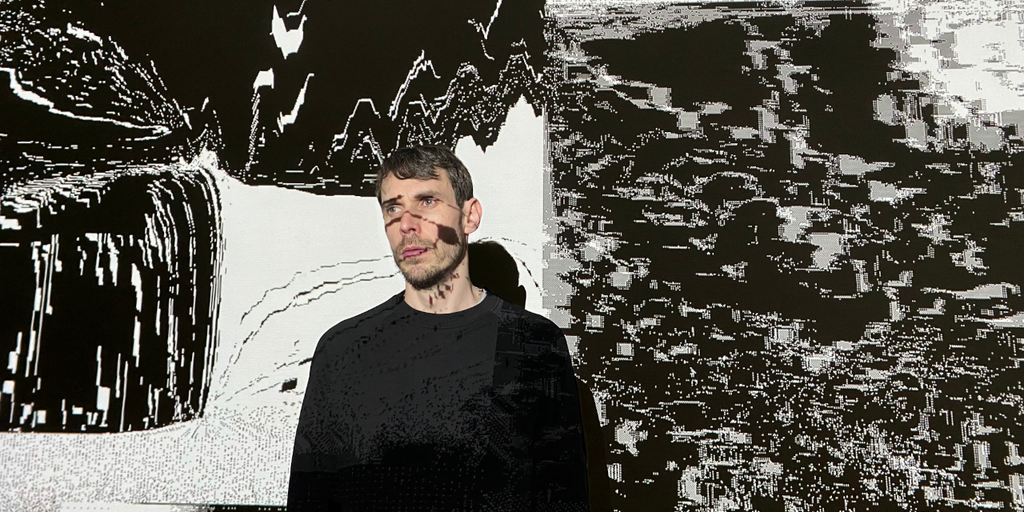Meet Kim Asendorf: The Metallica Video Director Who Makes NFT Art Designed to Hypnotize

Fresh off co-directing Metallica’s “Chasing Light” music video, which featured his artwork, digital expressionist and internet artist Kim Asendorf has revealed his latest NFT drop.
Curated by Peggy Schoenegge for the Feral File platform, Asendorf’s “Colors of Noise” is a series of 50 unique artworks minted on Ethereum, of which 47 pieces will be sold on Thursday, May 18 for 0.25 ETH (about $450) each.
“Each one is an ode to sound design,” says the German artist Decryptwith the project marking the first time in his career that he has brought visual and sound art together.
Using the Web Audio API to generate white noise, Asendorf created a filter to separate the various colored noises within it. The waveform of the various sounds was then recreated within a four pixel high wave, which became the trigger for the accompanying animation.
“It’s a very experimental mix of automated algorithms and reaction diffusion algorithms that recreate what I feel when I hear these sounds,” explains Asendorf, with 16 different animations on offer and three components for each piece. Pressing play starts the audiovisual art, while the waveform is frozen in place as the triggered animations fade out.
With color noise already defined by sound technology science, plus one created by Asendorf himself (yellow noise), “Colors of Noise” is an immersive piece of work that never repeats itself thanks to generated noise and animations that react in real time. The idea is that each NFT can cause a reaction in humans as well.
“I don’t really see it as interactive art,” Asendorf says. “People should hopefully just be interested in seeing it, let it sink in, and maybe let it hypnotize them for a while.”
Asendorf says he’s “always been interested in electronic music” and the sounds that can be made with both digital and analog synthesizers, adding that he finds it fascinating to see how people respond to everyday sounds.
“I don’t know if it’s the same for everyone, but some sounds are very calming,” he continues. “Some you hear all the time, but the brain filters them out.”
White noise usually helps a person sleep, pink noise promotes concentration, and brown noise improves relaxation. “Colors of Noise” is an artistic “investigation” of how people feel when they hear these different sounds.
“It’s experimental, because I have no idea how people will feel when exposed to them,” Asendorf explains. “With things like Instagram, you just keep scrolling even if you see something you like. My work needs time to sink in, but hopefully people will find it interesting enough to stop scrolling.”
“People will need time to find out if they like it, if it helps them, or if it disturbs them,” he adds.
Originally, the “Colors of Noise” NFTs were to be generated completely randomly – but after Asendorf saw what had been created, he decided to step in and curate the series. “I really had to compose each piece so that I liked each output and each one made sense to me,” he says.
Feral File describes the project as living at the “intersection between art and technology”, but Asendorf doesn’t see the distinction. “I grew up with computers, Nintendo consoles and Game Boys. I feel like a native to this technology, so using it to create art just feels natural, he says.
Going forward, Asendorf wants to incorporate more sound into his work to create more audiovisual and sound-reactive pieces. He is currently developing a few tools to help him with this, including MIDI controllers for a web browser. It comes after he co-directed the recent video for Metallica’s “Chasing Light” with Dina Chang, and the clip used animations that were “slightly” sound reactive.
The technology behind “Colors of Noise” is not designed to work live in a gig scenario, generating visual elements that an artist plays, due to the different frequencies and the high compression of the sound. However, Asendorf wants to “explore” how his work can be used in the context of sound performance. There’s already Vjay software that does the job, but Asendorf wants to “try to find my own unconventional way of connecting these things.”
Asendorf describes his work as an “outtake”, and likes how it can be made in a “low-tech environment” with just a computer, a code editor and the internet. He has been creating digital art for close to 20 years now, but believes there is a “new dynamic” at play with the rise of Web3.
“Now you don’t have all the closed brands, it feels a lot more personal,” he says. “You also have direct contact with collectors. They tell you that a piece of you has been running non-stop on a screen in their house for a week straight, which is incredible. You can recreate a museum experience at home, and it’s great to know that your work is actually in other people’s lives.”

























